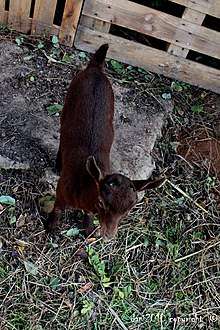Murciano-Granadina
The Murciano-Granadina is a Spanish breed of dairy goat. It was created in 1975 when two existing breeds, the mahogany-coloured Murciana of Murcia and the black Granadina of Granada, began to be hybridised as a result of the official recognition of a single herdbook including both breeds.[2]:396[5] It is the most important dairy goat breed of Spain,[6] with more than 500,000 milking females.[7] It originated in the semi arid areas in south eastern Spain, including parts of Murcia, Almería, Granada and Alicante. They were bred for two main traits, milk production and its ability to continue this production in dry and nutrient poor regions. They have been introduced into several areas in Latin America as well as northern Africa.
 Two-month-old kid | |
| Conservation status | FAO (2007): not a risk[1]:146 |
|---|---|
| Other names | |
| Country of origin | Spain |
| Distribution | |
| Use | dairy |
| Traits | |
| Weight | |
| Height | |
| |
Characteristics
These goats are medium size for goats, around 30 to 50 kg for females and 50–60 kg for males. They are solid colored, usually black or mahogany colored. The breed association, ACRIMUR (Asociación Española de Criadores de la Cabra Murciano-Granadina, or Spanish Association of Breeders of the Murcia-Granada Goat) states that they refuse to accept any goat that had white hair even in the smallest amount as M-G. The goats have erect ears and tails, with a short, coarse coat, though it is longer in males than in females. Genotyping of various goat breeds from southern Spain revealed that the Murciano-Granadina breed is significantly closer to the Murciana breed than any other, including the Granadina.[5]
These goats are very good milk producers, with a lactation period of around 210 days, often producing 500 liters of milk annually, with some individuals producing as much as twice that. Their milk has 5.6% fat, and 3.6% protein, which is better than most other goat breeds in Mediterranean Europe. In Spain this milk is primarily used for cheese production. They are also used for meat, especially due to the rapid development of their kids. The growth of Murcia-Granada kids can be improved by crossing females of this breed with a meat breed (Boer goats)
These goats reproduce quickly, since they do not have a particular season for breeding, and the females can come into heat at any time of the year. Usually two kids are born per breeding, and they become sexually mature around 7 to 8 months of age.
See also
References
| Wikimedia Commons has media related to Cabra murciano-granadina. |
- Barbara Rischkowsky, D. Pilling (eds.) (2007). List of breeds documented in the Global Databank for Animal Genetic Resources, annex to The State of the World's Animal Genetic Resources for Food and Agriculture. Rome: Food and Agriculture Organization of the United Nations. ISBN 9789251057629. Accessed January 2017.
- Valerie Porter, Lawrence Alderson, Stephen J.G. Hall, D. Phillip Sponenberg (2016). Mason's World Encyclopedia of Livestock Breeds and Breeding (sixth edition). Wallingford: CABI. ISBN 9781780647944.
- Miguel Fernández Rodríguez, Mariano Gómez Fernández, Juan Vicente Delgado Bermejo, Silvia Adán Belmonte, Miguel Jiménez Cabras (eds.) (2009). Guía de campo de las razas autóctonas españolas (in Spanish). Madrid: Ministerio de Medio Ambiente y Medio Rural y Marino. ISBN 9788449109461.
- Raza caprina Murciano-Granadina: Datos Morfológicos (in Spanish). Ministerio de Agriculturo, Pesca y Alimentación. Accessed October 2019.
- Martínez, A.M.; Vega-Pla, J.L.; León, J.M.; Camacho, M.E.; Delgado, J.V.; Ribeiro, M.N. (October 2010). "Is the Murciano-Granadina a single goat breed? A molecular genetics approach". Arquivo Brasileiro de Medicina Veterinária e Zootecnia. 62 (5): 1191–1198. doi:10.1590/S0102-09352010000500023.
- Juan Vicente Delgado, Vincenzo Landi, Cecilio José Barba, Javier Fernández, Mayra Mercedes Gómez, María Esperanza Camacho, María Amparo Martínez, Francisco Javier Navas, José Manuel León (2017). Murciano-Granadina Goat: A Spanish Local Breed Ready for the Challenges of the Twenty-First Century. In: J. Simões, C. Gutiérrez C. (editors) Sustainable Goat Production in Adverse Environments, Volume II: Local Goat Breeds. Springer, Cham. 205–219. ISBN 9783319712949. doi:10.1007/978-3-319-71294-9_15.
- Camacho, M. E.; Martínez, M.; León, J. M.; Quiroz, J.; Pleguezuelo, J.; Delgado, J.V. (15 March 2016). "Advances in the breeding program of the Murciano-Granadina dairy goat breed". Italian Journal of Animal Science. 6 (sup1): 56. doi:10.4081/ijas.2007.1s.56.